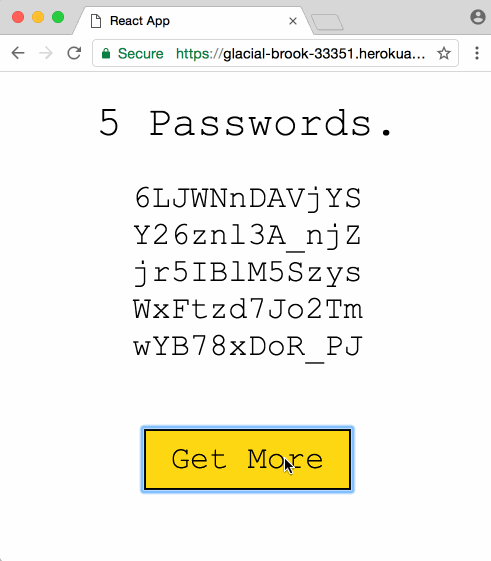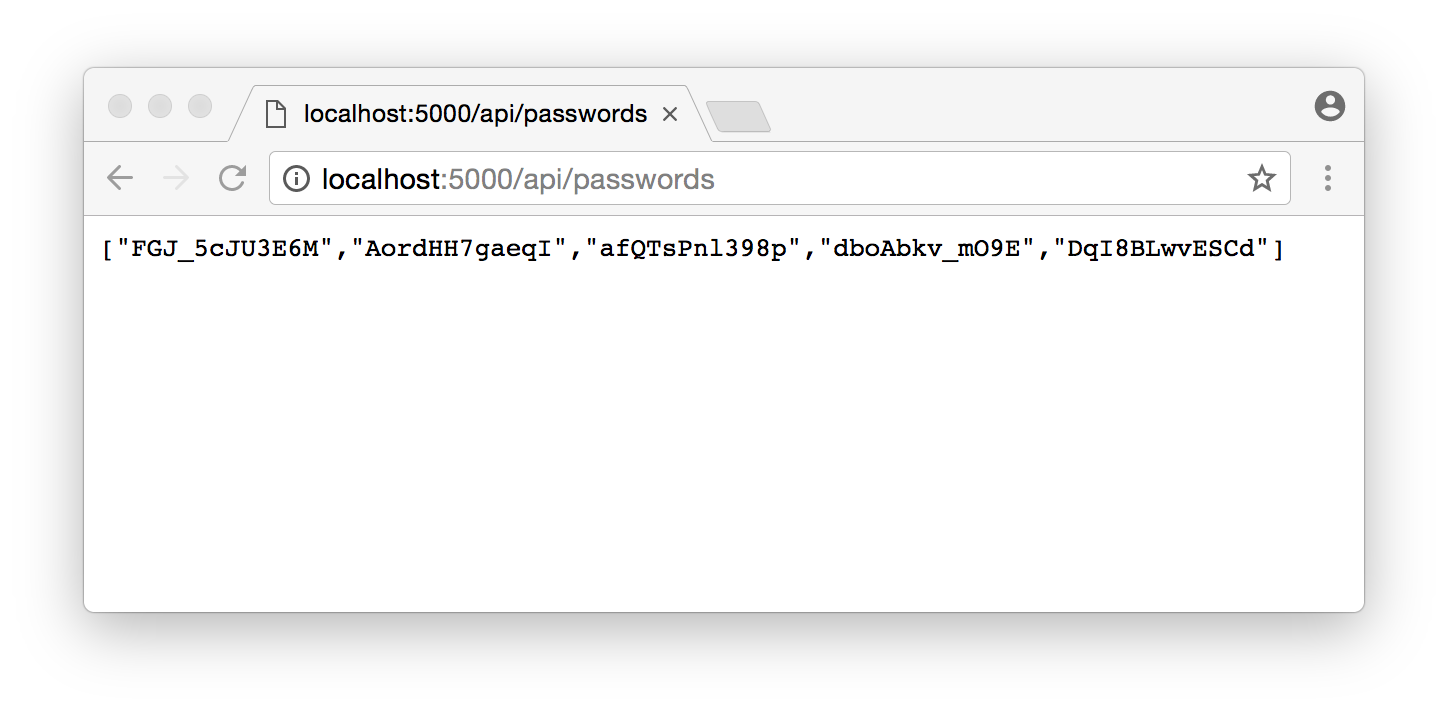Updated May 18, 2018
You’ve got a React app, and an API server written in Express or something else. Now – how do you deploy them both to a server?
There are a few ways to do this:
- Keep them together – Express and React files sit on the same machine, and Express does double duty: it serves the React files, and it also serves API requests.
- e.g., a DigitalOcean VPS running Express on port 80
- Split them apart – Host the Express API on one machine, and the React app on another.
- e.g., React app served by Amazon S3, API server running on a DigitalOcean VPS
- Put the API behind a proxy – Express and React app files sit on the same machine, but served by different servers
- e.g., NGINX webserver proxies API requests to the API server, and also serves React static files
This article will cover how to keep them together. We’ll build the Express server to serve React’s static files in addition to providing an API, and then deploy it to Heroku. Heroku is easy to deploy to and free to get started with.
Make a Heroku Account
If you don’t have one already, go here and sign up. It’s free.
Install Heroku Toolbelt
Heroku comes with a commandline command they call a “toolbelt.” Follow the instructions here to install it. (On a Mac with Homebrew, just brew install heroku).
The App
We’ll build a password generator. Every time you load the app or click Get More you’ll get 5 random paswords.

Just a quick disclaimer: this is just meant as a demo! I don’t recommend using some random internet thing that generates passwords on the server to generate your own real passwords ;)
Create the Express App
Make a parent directory to contain everything. Call it rando or whatever you want.
$ mkdir rando; cd randoInitialize the project with Yarn or NPM:
$ yarn init -y
# or npm init -yWe need 2 packages: Express itself, and a password generator. Install those now:
$ yarn add express password-generatorCreate a file called index.js, which will be the Express app, and type this in:
const express = require('express');
const path = require('path');
const generatePassword = require('password-generator');
const app = express();
// Serve static files from the React app
app.use(express.static(path.join(__dirname, 'client/build')));
// Put all API endpoints under '/api'
app.get('/api/passwords', (req, res) => {
const count = 5;
// Generate some passwords
const passwords = Array.from(Array(count).keys()).map(i =>
generatePassword(12, false)
)
// Return them as json
res.json(passwords);
console.log(`Sent ${count} passwords`);
});
// The "catchall" handler: for any request that doesn't
// match one above, send back React's index.html file.
app.get('*', (req, res) => {
res.sendFile(path.join(__dirname+'/client/build/index.html'));
});
const port = process.env.PORT || 5000;
app.listen(port);
console.log(`Password generator listening on ${port}`);We’re also going to need a “start” script in package.json, so that Heroku knows how to start the app. Open package.json and add a scripts section at the bottom. The full file should look something like this:
{
"name": "rando",
"version": "1.0.0",
"main": "index.js",
"license": "MIT",
"dependencies": {
"express": "^4.15.3",
"password-generator": "^2.1.0"
},
"scripts": {
"start": "node index.js"
}
}Test It
It’s always good to make sure things are working as you go along. Much better than getting to the end and realizing nothing works. So, let’s try it out.
Start up the Express app by running:
$ yarn startOpen up your browser and go to http://localhost:5000/api/passwords. You should see something like this:

Set Up Heroku
Now we’ll deploy the app to Heroku, make sure it works, and then we’ll add React to the mix.
Git Init
Heroku needs your project to have a Git repository, so we’ll create one along with a .gitignore file to ignore node_modules, and then commit the code:
$ git init
$ echo node_modules > .gitignore
$ git add .
$ git commit -m "Initial commit"Now we’re ready for Heroku. Run its ‘create’ command:
$ heroku createAnd you’ll see something like this:

To make it work, we just need to push up our code by running:
$ git push heroku masterIt will print out a bunch of stuff, and then the app will be live. One of the last lines will tell you the URL of the app:

Now you can go to <your url>/api/passwords and make sure it works.
Woohoo! You’ve got an app live on the real internet! Except it’s not very nice to use, yet. Let’s add a React frontend now.
Create the React App
We’re going to use Create React App to generate a project. Remember that we decided the React app would live in the “client” folder? (we did, back when we set up Express to point to “client/build” for static assets).
If you don’t have Create React App installed yet, do that first:
$ yarn global add create-react-app
# or npm install -g create-react-appGenerate the React app inside the Express app directory:
$ create-react-app clientCreate React App will proxy API requests from the React app to the Express app if we add a “proxy” key in package.json like this:
"proxy": "http://localhost:5000"This goes in client/package.json, not in the Express app’s package.json, and it will be ignored by Heroku after deploying.
Open up src/App.js and replace it with this:
import React, { Component } from 'react';
import './App.css';
class App extends Component {
// Initialize state
state = { passwords: [] }
// Fetch passwords after first mount
componentDidMount() {
this.getPasswords();
}
getPasswords = () => {
// Get the passwords and store them in state
fetch('/api/passwords')
.then(res => res.json())
.then(passwords => this.setState({ passwords }));
}
render() {
const { passwords } = this.state;
return (
<div className="App">
{/* Render the passwords if we have them */}
{passwords.length ? (
<div>
<h1>5 Passwords.</h1>
<ul className="passwords">
{/*
Generally it's bad to use "index" as a key.
It's ok for this example because there will always
be the same number of passwords, and they never
change positions in the array.
*/}
{passwords.map((password, index) =>
<li key={index}>
{password}
</li>
)}
</ul>
<button
className="more"
onClick={this.getPasswords}>
Get More
</button>
</div>
) : (
// Render a helpful message otherwise
<div>
<h1>No passwords :(</h1>
<button
className="more"
onClick={this.getPasswords}>
Try Again?
</button>
</div>
)}
</div>
);
}
}
export default App;You can update the CSS too, if you like (in src/App.css):
.App {
text-align: center;
font-family: "Courier New", monospace;
width: 100%;
}
h1 {
font-weight: normal;
font-size: 42px;
}
.passwords {
list-style: none;
padding: 0;
font-size: 32px;
margin-bottom: 2em;
}
.more {
font-size: 32px;
font-family: "Courier New", monospace;
border: 2px solid #000;
background-color: #fff;
padding: 10px 25px;
}
.more:hover {
background-color: #FDD836;
}
.more:active {
background-color: #FFEFA9;
}I also recommend opening up src/index.js and removing the call to registerServiceWorker() at the bottom, since it can cause some confusing caching issues (like preventing you from accessing the API endpoints in a browser after you load the React app once).
Now start up the React app by running yarn start inside the client folder.
Make sure the Express app is running too: run yarn start from its folder as well.
Go to http://localhost:3000 and the app should be working! Now we can deploy the whole thing to Heroku.
Deploying to Heroku
When you deploy the app with the git push heroku master command, git copies all the checked-in files up to Heroku. There are two complications now:
- We need to check in the new
clientcode - Express depends on the built client code in
client/build, which we don’t have yet, and which we’d rather not check in to git.
What we’ll do is tell Heroku to build the React app after we push up the code, and we can do that by adding a “heroku-postbuild” script in the top-level (Express app’s) package.json.
Using Yarn
If you’re using Yarn, the script looks like this:
"scripts": {
"start": "node index.js",
"heroku-postbuild": "cd client && yarn && yarn run build"
}This tells Heroku “hey, after you’re done doing what you do, go into the client folder and build my React app.” The yarn run build script will kick off Create React App’s production build, which will put its output files in the client/build folder so Express can find them.
Using NPM
If you’re using NPM, the script will look like this:
"scripts": {
"start": "node index.js",
"heroku-postbuild": "cd client && npm install && npm run build"
}This tells Heroku “hey, after you’re done doing what you do, go into the client folder and build my React app.” The npm run build script will kick off Create React App’s production build, which will put its output files in the client/build folder so Express can find them.
Thanks to Matthew Locke and Babajide Ibiayo in the comments for how to get this working with NPM.
Time to Deploy
Once you have configured the heroku-postbuild step for Yarn (or NPM), add everything to git and commit it. Make sure to run this from the top-level rando directory, not inside client:
$ git add .
$ git commit -m "Ready for awesome"If you run git status now, you should see no red items.
Then you can deploy the app by running:
$ git push heroku masterIt again prints out your app’s hostname. Mine is https://glacial-brook-33351.herokuapp.com/. Go there and try it out!
Congrats, you’ve got a React + Express app in production ;)
Get the Code
The complete app can be found on Github, and the README there explains how to deploy it.
Check out the npm branch with git checkout npm if you want to use NPM. From there, the deploy will differ slightly – run git push heroku npm:master to deploy the npm branch insead of master.